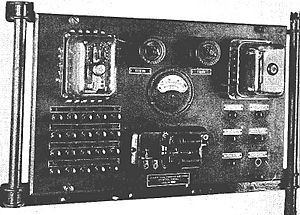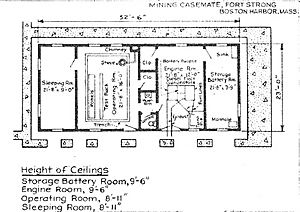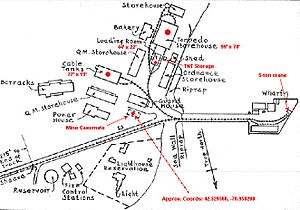Submarine mines in United States harbor defense facts for kids
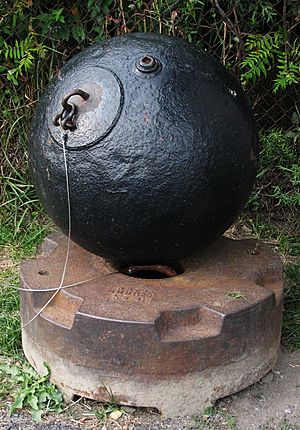
Imagine protecting a harbor from enemy ships. One important way the United States did this was by using "controlled mines." These were underwater explosives, sometimes called "submarine mines." They were a key part of US harbor defenses from about 1900 until 1947.
Contents
A Quick Look at History
In 1866, the United States Army Corps of Engineers started a special school at Willets Point, New York. Major Henry Larcom Abbot was a very important person there. He designed and oversaw how mines would be used to defend American harbors.
Abbot spent over ten years experimenting with underwater explosives. He tested fuzes, cables, and electrical gear. By 1876, he published the first guides on using mines for coast defense. An early minefield was even set up at Fort Mifflin in Pennsylvania. However, funding for these defenses stopped in 1878.
New Plans for Defense
In 1886, a group called the Endicott Board made a big report. They suggested many new minefields and gun defenses. This led to a huge growth in building modern forts and installing new guns. Mine defenses were also prepared at major seaports. These areas were called Artillery Districts, later known as Coast Defense Commands.
During the Spanish–American War, mines were placed at 28 harbors. Many important lessons were learned from this experience. In 1901, the job of handling underwater mines moved from the Corps of Engineers to the Artillery Corps. This became a main duty of the Coast Artillery Corps when it was formed in 1907.
Special Mine Ships
In 1904, the first US Army mine planters were built. These were small ships used to place and remove controlled mines. By 1918, the U.S. Army Mine Planter Service (AMPS) was created. Their job was to keep US mine defenses ready.
From about 1900 to 1946, the mine defense program grew. The Coast Artillery Corps maintained over 10,000 controlled mines. By 1940, about 27 Harbor Defense Commands had minefields. This included at least five overseas locations.
In 1943, floating mines were replaced with "ground mines." These mines rested on the seabed. This change happened because during World War II, large ships sometimes got tangled in the cables of deactivated floating mines.
How Controlled Mines Worked
Controlled mines were placed in a harbor. Some, called ground mines, sat on the bottom. Others, called buoyant mines, floated at different depths. These depths could range from about 20 to 250 feet (6–75 meters).
These mines were set off electrically. A huge network of underwater cables connected them to shore. Mines could be set to explode when touched. Or, an operator could trigger them. This decision was based on where enemy ships were located.
The Mine Control Center
The cables from the mines ended on shore in large concrete bunkers. These bunkers were called mine casemates. They were usually buried under protective layers of earth.
The mine casemate was like the "brain" of the minefield. It held electrical generators, batteries, and control panels. Soldiers worked there to test the mines and fire them when needed.
For example, a map of Boston Harbor's minefields from 1945 (see image below) shows 30 groups of mines. Each group had 19 mines. Each mine usually held 200 pounds (91 kg) of TNT. So, Boston Harbor was guarded by a total of 57 tons of explosives!
It's interesting to note that mines were almost never fired at an enemy. The only known time was in the Philippines in 1941-42. There was a report of a submarine trying to enter Boston Harbor in June 1942. But it supposedly left before the mines could be fired.
Mine Planters and Shore Facilities
Each protected harbor also had a small fleet of mine planters and tenders. These ships were used to place mines in exact patterns. They also pulled mines up to check them or bring them ashore for repairs.
On shore, there were special buildings to store the mines. These were called "torpedo storehouses." They also stored the TNT used to fill the mines. Rail systems helped load and move the mines, which often weighed over 750 pounds (340 kg) each when loaded. There were also places to test and fix the electrical cables.
Special "fire control structures" were built too. These were used to watch the mine-planting process. They helped figure out the exact location of each mine. They also tracked enemy ships. This helped operators know when to detonate specific mines. This was called "observed fire."
The most common way to use mines was to set them to explode a few seconds after being touched. This meant observers didn't have to spot every target ship.
Controlling the Mines
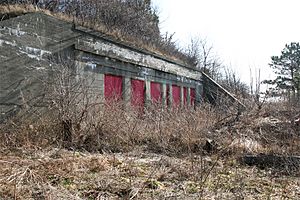
Each mine casemate controlled about 150 to 300 mines. These mines were arranged in groups of 19. Mines in a group were usually placed about 100 feet (30 m) apart. They formed lines across the channel being protected. This meant one group of mines could protect a distance of about 1,900 feet (580 m).
About 3 miles (4.8 km) of cable were needed to connect one group of 19 mines to its distribution box. The cables spread out from the box like spokes on a wheel. If more groups of mines were needed, more mine casemates were built. For example, Boston Harbor had three mine casemates.
The cable from each mine group's underwater distribution box ran back to a cable hut on shore. From there, it went into the casemate itself. Inside, it connected to a mine control panel. These panels were in the casemate's operating room.
The mine casemate also had electric generators and many storage batteries. The generators made direct current (DC) to show if the mines were ready. A special device changed some of this current to alternating current (AC). This AC was used to fire the mines, as a safety feature.
The casemate also had telephone lines. These connected it to mine observation points, the mine commander, and gun batteries. This allowed everyone to work together. The casemate also had equipment to test cables and switches.
For example, the largest mine casemate in Boston Harbor controlled 15 mine groups (285 mines). It would have had 15 mine control panels. Plus, it had other devices to control its generators and battery systems.
How Mines Were Fired
Mines could be fired in three main ways:
- Delayed Contact Fire: The mine was set to explode a few seconds after it was touched or tipped.
- Contact Fire: The mine was set to explode as soon as it was touched or tipped.
- Observation Fire: Observers tracked a target ship. They would then tell the casemate when the ship was in the right spot. Then, the correct mine in its path would be fired.
Delayed contact fire was often preferred. The idea was that the mine would be dragged under the ship first. Then, after a few seconds, it would explode under a less protected part of the ship's bottom. For this, soldiers in the casemate would hear a bell and see a light when a mine was tipped. They would wait a few seconds, then flip a switch to detonate the mine.
In contact fire mode, each mine in a group would explode when a ship touched it. In observed fire mode, mines were fired like big guns. Distant observers used telescopes to find targets. They would then plot the target's position.
Contact fire or delayed contact fire was useful when many enemy ships were coming quickly. It was also good in bad weather when visibility was poor. However, these methods were more dangerous for friendly ships near the minefield.
Taking Care of the Mines

Each mine casemate had many facilities on shore and a small fleet of mine-planting boats. For Fort Strong in Boston Harbor, these facilities are shown in the map at right.
The mine wharf was where mine planters docked. They loaded or unloaded mines and cables there. This wharf had a heavy crane for lifting. From the wharf, mines were moved by a "mine tramway" (a rail system). They went to the "torpedo storehouse." ("Torpedo" was an old word for "mine.")
This storehouse was the largest building. It stored mines on big racks when they were pulled from the water. This happened for testing, repairs, or long-term storage. Loaded mines were also stored in underground rooms of old gun batteries.
Another part of the tramway led to the loading room. Here, TNT charges were put into or taken out of the mines. A small TNT storehouse was right next to the loading room. Only a small amount of TNT (100 pounds or 45 kg) was supposed to be taken out at a time for loading.
Another tramway track led to the cable tanks. These were large concrete tanks filled with seawater. They were used to test the many miles of electrical cable for mine operations. The torpedo storehouse also had smaller tanks. These were used to test the mine casings and their fuzes underwater.
The mine casemate itself is also shown on the map. Most of these mine facilities were removed by the City of Boston in the 1990s. This was done to turn the area into a summer camp for children.




